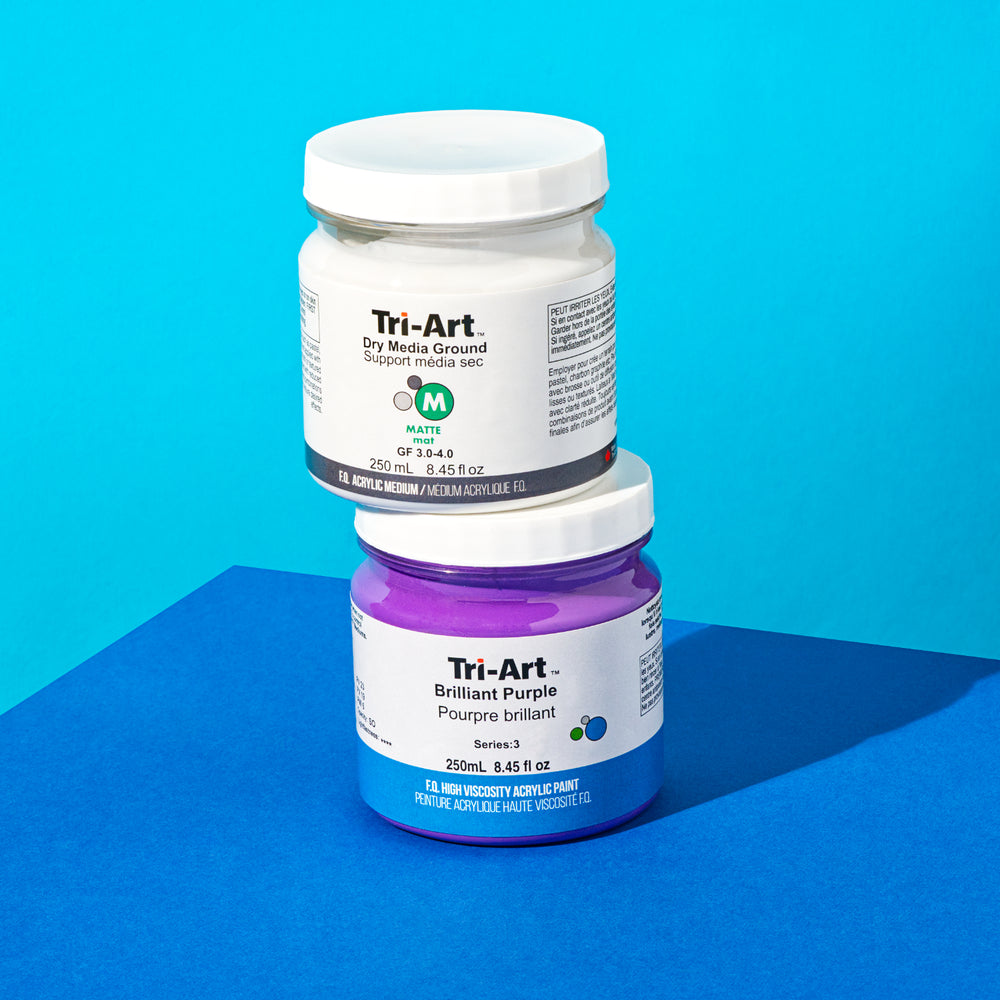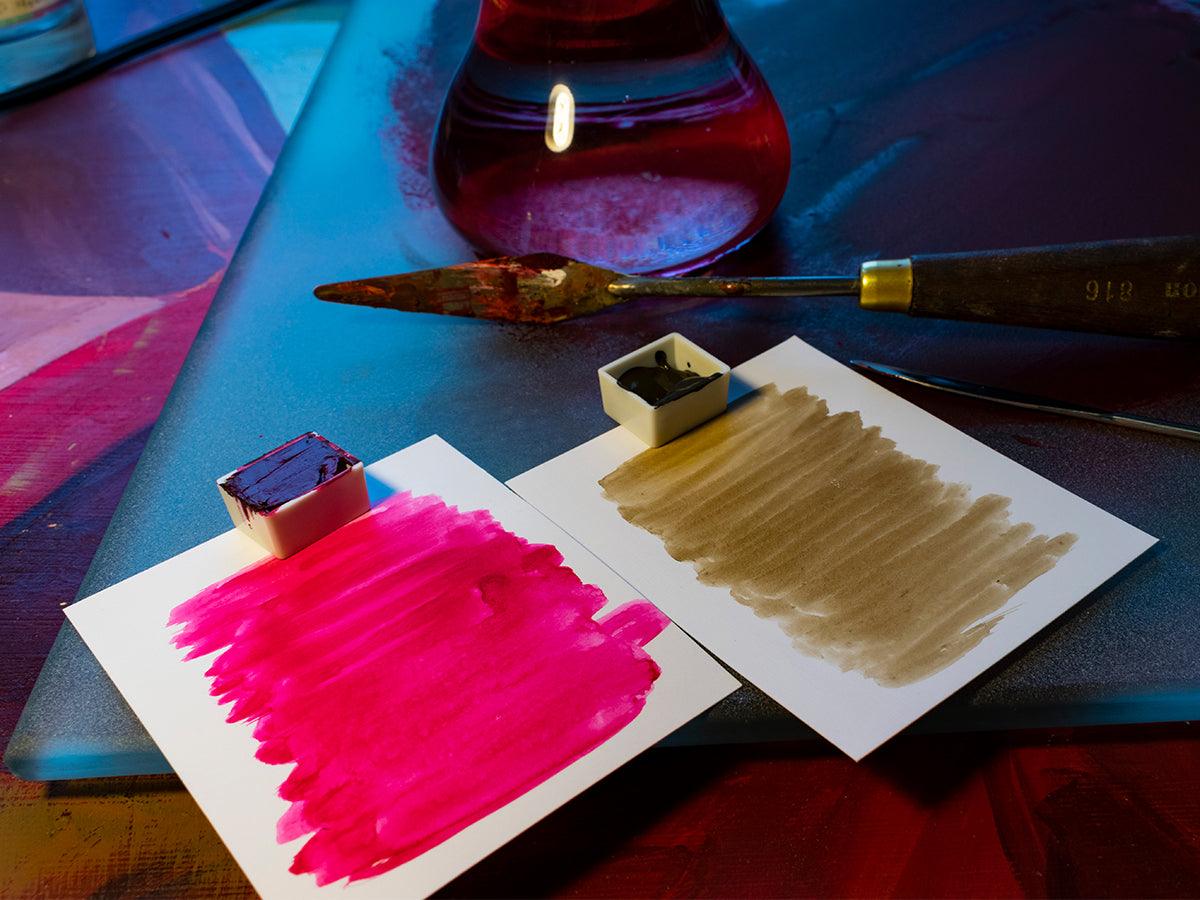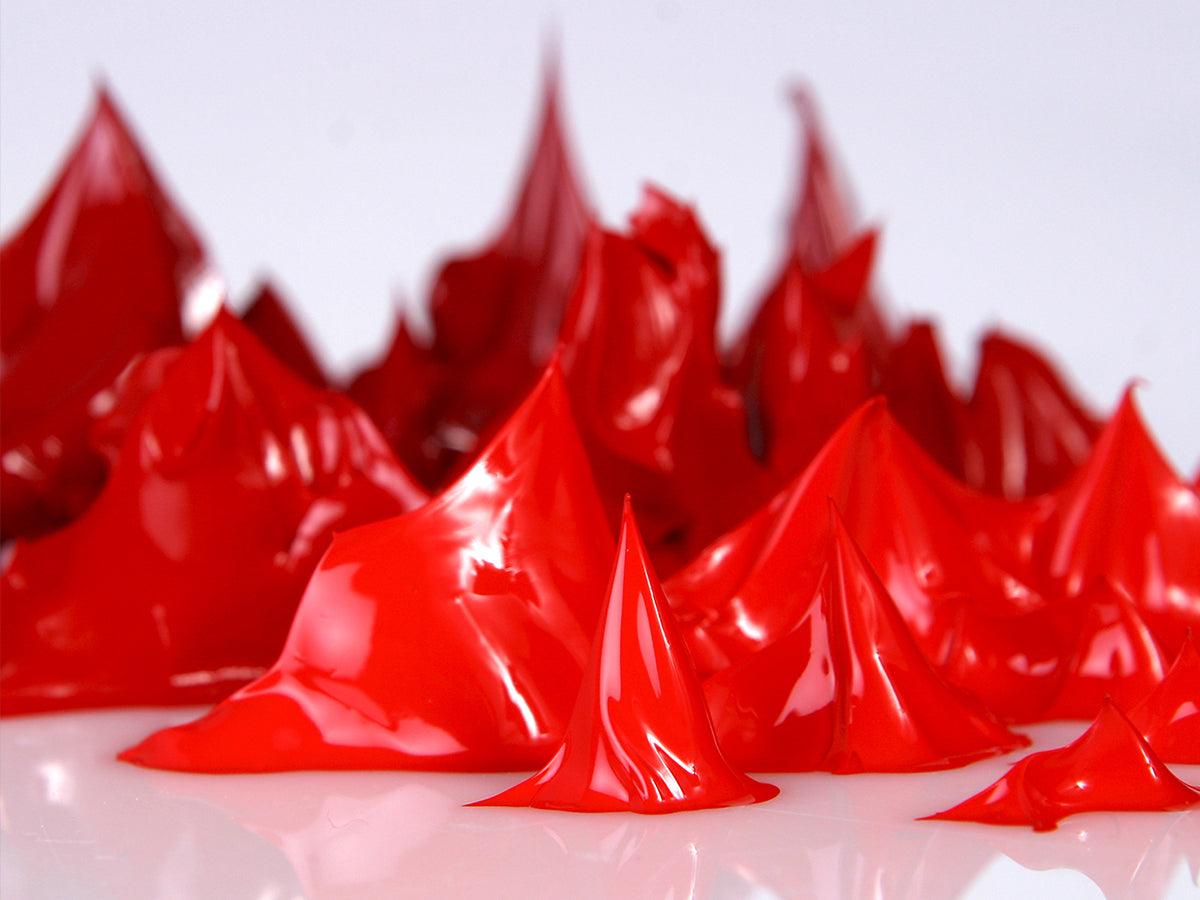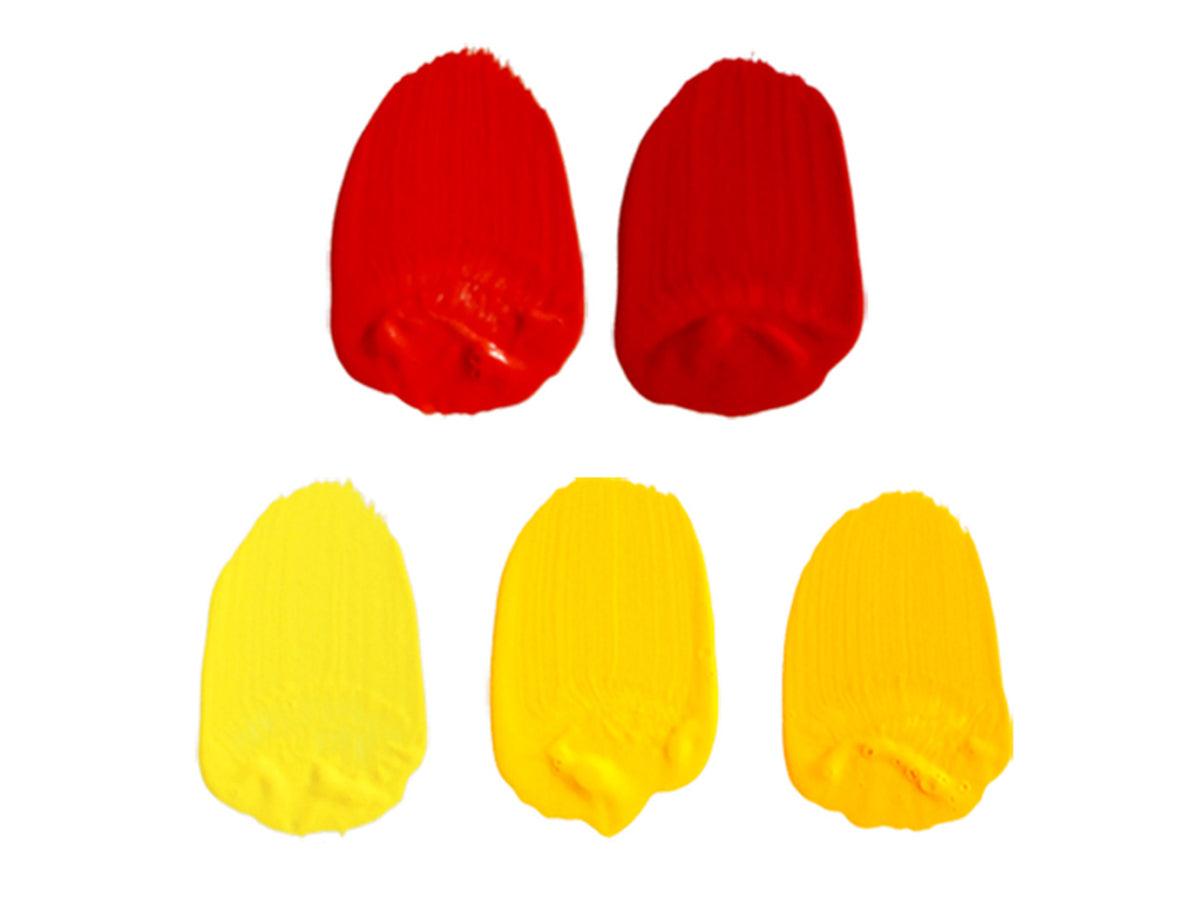The founder and owner of Tri-Art, Steve Ginsberg, often reminds us that paint is the raw material of an artwork – an artist must endeavour to transform paint into a finished piece. Just as paint by itself does not make a painting, pigments do not simply make paint – the manufacture of paint requires the careful manipulation of raw ingredients and techniques to produce not only paint, but high-quality artists’ paint. Pigment grinding is the essential step that allows powdered pigments to be transformed into smooth, liquid paint. The process is in itself an art form that receives little attention, even in the world of artists’ supplies. While pigment load is often given primacy over all else when evaluating paint, the quality of the pigment’s dispersion is just as critical when bringing out the best in each pigment.
AGGREGATING DATA: A BRIEF PRIMER ON GRINDING PIGMENTS
While pigments appear to be fine powders composed of evenly ground particles, these particles clump together on a very small-scale forming aggregates. These clumped together particles can have significant effects on the final appearance of the paint: they can appear as physical gritty particles, lower the color intensity (chroma) of the paint, and effect the opacity or transparency of the paint. Clumped particles can lower the opacity of an opaque colour, or confusingly lower the transparency of a transparent colour. When aiming for opacity, dispersing these particles is critical to attainting maximum covering powering. When it comes to transparent colours, these aggregated particles of pigment can also trap pockets of internal air that scatter light.[1] Rather than allowing light to pass through, these air pockets create paint that looks hazy, like frosted glass. Therefore, one of the primary functions of pigment grinding, as suggested by the name, is to break apart these aggregates to create an even dispersion.

The traditional techniques of grinding pigment have gone unchanged for centuries. Handmade paint using a muller and glass slab is making a resurgence today. With gentle circles of the muller, the pigment is dispersed into a medium, like gum Arabic for watercolour or linseed oil for oil paints. The action of the muller against the glass shears apart the aggregated pigment particles and replaces any air with the binder of choice.


ACRYLICS: MODERN AND MULLERS DON’T MIX
Despite a Renaissance of handmade paint, nearly all artists today buy their paint premade, and for good reasons. Working with dry, powdered pigments alone is health hazard, and quite a messy undertaking. When it comes to making acrylics, the process is even more difficult. Ignoring the complex formulation and stepwise process necessary to create acrylic paint from its raw materials, if you wanted to mix a premade acrylic medium with pigment you would find the results might not be what you hoped. Acrylic emulsion paints cannot truly be mulled by hand like oil or watercolour because they rapidly dry and are not resoluble. Mixing a paint from pigment takes considerable time, the paint must be carefully mulled, tested, and mulled further, often with adjusting the amount of pigment or binder added. This is time that acrylic paint does not allow for.
Acrylic paints are really only possible thanks to the industrial and chemical advances of the 19th century and the post-war era. By the 19th century, oil paints were not being made just by hand with mullers. Mechanical, large-scale, roller mills were developed for commercial artists paint production. These allowed for larger volumes of paint to be produced, with more evenly dispersed pigments than could be produced by hand. With the invention of the metal paint tube in 1841, most artists would buy their paints premade from colourmen and art stores.[2] When water-based acrylics were introduced in the 20th century (in the early 1960s several companies introduced emulsion paints) they still, however, came with significant manufacturing challenges.
To overcome the challenges of grinding dry pigment directly into acrylic paint colourant dispersions (or pastes/slurries) became common in the 1970s[3]. These are highly concentrated, water-based precursors that allow a thorough grinding of the pigment without having to contend with the many other ingredients of acrylic paint. Many of us will be familiar with a similar product and concept, the liquid colourants added to an uncolored can of commercial wall paint at a hardware store. These products however cannot hold a candle to artists quality paints that have been devotedly crafted.
TRI-COLOUR, TRI-PHASE: MAKING MODERN PIGMENT DISPERSIONS
To produce colorful dispersions for acrylic paints, pigments are ground in three phases: wetting, dispersing and stabilizing. [4] Most pigments are hydrophobic, meaning they do not mix with water, and would rather stick to themselves. Oil paints are at an advantage here, with many pigments readily absorbing oil and wetting out. Water-based dispersions thus require synthetic wetting agents. Although these may sound unfamiliar, wetting agents are nothing more than surfactants – the chemicals like sodium lauryl sulfate that make up our everyday detergents and soaps. They are molecules with polar and non-polar portions that bridge non-polar substances, like pigments, with highly polar water.


Tri-Art uses not one, but an array of surfactants that have come from years of testing. By carefully attuning the surfactant used, the maximum amount of pigment can be wet out and dispersed into the solution. By aiming for the highest concentration of pigment possible in these dispersions, Tri-Art has been able to create an incredibly high pigment load in their finest quality acrylic paints.
Once the pigment is wetted into water it is then ready for dispersion – the breaking of the aggregate particles. During this phase high mechanical forces are critical to grind the pigment.[5] At Tri-Art two processes are used to disperse the pigment as effectively and efficiently as possible. The first process is high speed mixing with a cowles blade. The outer edge of the blade reaches a speed magnitudes higher than the shaft of the mixer, thereby imparting high shear forces throughout the solution that break apart aggregate particles. This is typically able to produces particles smaller than 250 um, and comfortably within the range of 30-40 um that most artists pigments are formulated for use at.[6] For synthetic organic pigments like Quinacridone red that tend to stick together, a second step is necessary to further break up the very fine particles. Bead milling is able to decrease the particle size to less than ten um if desired.[7] This technique employees a cylinder filled with several kilograms of small industrial ceramic beads (less than two millimeters in diameter). The beads are spun by an agitator that cause the beads to collide with each other. Their resulting impact force grinds apart pigment aggregates between the ceramic balls. The process is energetic enough to produce a considerable amount of heat, so a constant flow of water in employed in a cold-water jacket to keep the dispersion from overheating.




The last step of grinding the pigment into a concentrated solution is to stabilize the newly dispersed particles. Because of their affinity for each other, the particles must often be stabilized to prevent them from reforming the aggregate particles they once made up. Stabilizers are added that absorb onto the surface of each pigment particle, coating them in a repellent that balances all the particles an atomic distance apart from each other. These are most commonly acrylic polymer salts – chemically very similar to the acrylic polymers that will make up the finished paint, they will provide stabilization without interfering with the final formulation. The mixture can be further stabilized with acrylic resins (acrylic paint binder) forming a slurry that is then ready to be mixed into a multitude of paint formulations.[8]
DISCERNING DISPERSIONS: WHY DOES THE QUALITY OF A GRIND MATTER?
Pigment grinding is critical to the final outcome of the paint because a high-quality grind allows for high pigment loading, but just as importantly, a high-quality grind allows for control of the pigment’s characteristic hue, transparency/opacity, gloss/matte qualities, and staining power. When it comes to single pigment artists’ qualities paints, it takes care to achieve not only an excellent quality pigment dispersion each batch, but one that is consistent from batch to batch too. For these single pigment paints, as the name suggests, any discrepancy in hue cannot be adjusted for with other colours – this would affect the mass tone and undertones, and colour mixing properties of the paint, critical for the painter who has selected these colours to work with.
Take for instance earth pigments like raw umber. It’s come be known as notoriously difficult pigment here at Tri-Art. The earth pigment contains a portion of inorganic iron oxide and another of organic carbon black. Inorganic pigments can typically be dispersed at high speed with a cowles blade in little time (20-40 minutes), but the organic carbon black remains as undispersed particles. The resulting colour is warmer than it should be, with considerable streaks. Some manufactures might simply stop here with a ‘time is money’ attitude, but at Tri-Art we persevere on until all portions of the pigment are full dispersed – a product of careful surfactant attenuation and further grinding processes.


In the lab we carefully test for the consistency of these colours with several methods: measuring the size of the particles with a fineness of grind gauge, making a small bespoke batch of paint to compare to our standards, and undertaking rub-up tests. The latter is particularly good for quick testing dispersions. A dispersion is coated onto a card and a small spot is rubbed (swirled) while still wet. After allowing it to dry, poorly dispersed, unstable particles will be shown by a color change where the rub-up has disturbed them. In properly dispersed and stabilized mixtures the color will remain largely the same, as the rub-up simply moves the homogenized, stable dispersion around.[9]


TESTING HANDMADE DISPERSIONS
My own experiments with pigment grinding focused on two difficult pigments we work with at Tri-Art manufacturing: raw umber and quinacridone magenta. Quinacridone red is modern, synthetic, dye-like pigment. Its small organic particles would rather stick to each other than disperse into paint. I could tell just by looking at these pigment powders under magnification that I had some significant clumps that I would have to work out in this paint.


Watercolours are particularly suited to hand mulling. The (re)solubility of gum Arabic means that water can simply be dropped back onto the plate as the paint is being dispersed by the action of the muller. Here you can see that even with an initial mulling my raw umber paint has a gritty texture to it. Both paints at this stage were also lacking saturation, seen in my paint outs in the next figure. With successive mulling, the paints became smooth and pleasantly thick watercolour. I painted out more swatches as I went, watching the colour saturation increase as the pigment particles were dispersed.


Despite several minutes of mulling the paint mixture, some particles are still apparent in the paint out of raw umber, but overall, I was very happy with results. Hand mulling pigment and watercolour medium resulted in a richly pigmented paint that showcased the vivid and chromatic quinacridone red and brought out the coolness of the raw umber. With a successful start, I turned my attention to the real challenged, could I mix a workable paint with pigment and acrylic medium?


skip the hassle and shop the best:
Mixing raw umber pigment directly with acrylic medium with just a palette knife produced a gritty paint that very quickly highlighted for me the difficulties of grinding pigment directly into acrylics. The medium dried so quickly that little time was available for me to work the pigment into the paint. Adding more medium allowed me a longer working time, and with this I achieved a slightly less gritty texture, but not one that I would deem successful by any means. I knew that if the inorganic particles of iron oxide I could see were not being dispersed, the much smaller carbon black for sure were still largely clumped together as well.


Despite being a much finer particle, quinacridone red didn’t fare much better. I needed a liquid dispersion that I could grind then incorporate into the fast-drying acrylic. With my fresh, successful watercolour at hand I attempted a slightly unconventional pairing. A mixture of watercolour and acrylic produced a richly pigment paint film, one that seemed promising at first. After allowing my paint to dry, I notice both films had a considerable concentration of aggregated particles – perhaps pigment, perhaps slightly dried medium from the mixing process. The glossy richness faded, leaving a dull matte surface that no longer showcased the vibrancy of my quinacridone red. While certainly not a combination I would ever advise for a working artist, the experiment solidified for me the difficulties of working pigments and water-based acrylic mediums.


BACK TO THE GRIND: THE EVERYDAY TAKEAWAYS OF PIGMENT GRINDING
It may require the careful finesse of an expert paint maker, but the benefits of properly ground pigments are clear. An excellent dispersion allows for the formulation of paint that is smooth (it never should be gritty) while balanced with a range of high to low gloss specific to each pigment. Furthermore, it creates paint with a consistent mass- and undertone that allows for tinting and colour mixing without a tendency towards a lack of chroma or muddy hues. If you find that a drop of titanium white turns you colours ‘beyond the pale,’ that your colours lack saturation, your glazes are hazy, or your paints have little covering power, you may want to consider evaluating the quality of your paints - especially when it comes to acrylics.
When selecting acrylic paint, be sure to choose only artists quality acrylics, made by a reputable brand that stand by their products. If budget is a consideration for your work, be sure to do your homework before purchasing what is simply within your reach. Pigments, by a lion’s share, are the most expensive part of any paint formulation. Manufacturers that take the time to fully grind and disperse pigments can utilize less pigment to produce their budget lines, while retaining quality of colour, without the use of cheap fillers. Not only can expert pigment grinding amount to savings on the upfront cost of a budget quality line, but also the cost-per-use, as these are generally higher quality products with more saturation and staining power. By mastering pigment grinding for our own finest quality artists lines at Tri-Art, we are also able to offer a high quality student and kids line, at a very competitive price as well.
Shop the best - available at a price point for anyone - from Tri-Art:
BIBLIOGRAPHY
Agbo, Christiana, Wizi Jakpa, Bismark Sarkodie, Andrews Boakye, and Shaohai Fu, ‘A Review on the Mechanism of Pigment Dispersion’, Journal of Dispersion Science and Technology, 39.6 (2018), 874–89 <https://doi.org/10.1080/01932691.2017.1406367>
Mäntynen, Antti, Alexey Zakharov, Sirkka-Liisa Jämsä-Jounela, and Mats Graeffe, ‘Optimization of Grinding Parameters in the Production of Colorant Paste’, Powder Technology, 217 (2012), 216–22 <https://doi.org/10.1016/j.powtec.2011.10.029>
O’Hanlon, George, ‘Traditional Oil Painting: The Revival of Historical Artists’ Materials - Natural Pigments’, Natural Pigments, 2013 <https://www.naturalpigments.com/artist-materials/traditional-oil-painting-revival/> [accessed 19 January 2021]
Wetting and Dispersing Additives (BYK Additives and Instruments)
FOOTNOTES
[1] Wetting and Dispersing Additives (BYK Additives and Instruments).
[2] George O’Hanlon, ‘Traditional Oil Painting: The Revival of Historical Artists’ Materials - Natural Pigments’, Natural Pigments, 2013 <https://www.naturalpigments.com/artist-materials/traditional-oil-painting-revival/> [accessed 19 January 2021].
[3] Antti Mäntynen and others, ‘Optimization of Grinding Parameters in the Production of Colorant Paste’, Powder Technology, 217 (2012), 216–22 <https://doi.org/10.1016/j.powtec.2011.10.029>.
[4] Wetting and Dispersing Additives.
[5] Christiana Agbo and others, ‘A Review on the Mechanism of Pigment Dispersion’, Journal of Dispersion Science and Technology, 39.6 (2018), 874–89 <https://doi.org/10.1080/01932691.2017.1406367>.
[6] Mäntynen and others.
[7] Mäntynen and others.
[8] Wetting and Dispersing Additives.
[9] Wetting and Dispersing Additives.





